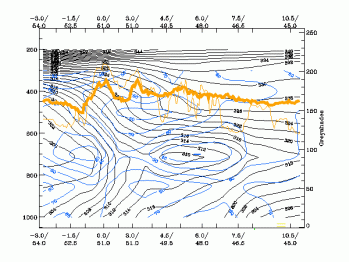Typical Appearance In Vertical Cross Sections
In front of the inclined crowding zone of a Cold Front system a second upper level Cold Front - like inclined crowding zone exists. In some cases this crowding zone can also extend into the lower levels. Further it often can be observed that the crowding zones of the upper level Cold Front and the crowding zone of the Warm Conveyor Belt are separated by a small trough of the isolines of equivalent potential temperature.
The relative humidity shows in the area of the Warm Conveyor Belt high values of about 70% and higher.
The distribution of the temperature advection shows a maximum of warm advection within the Warm Conveyor Belt in the mid- and upper levels of the troposphere.
In the satellite image the Warm Conveyor Belt is characterized by high pixel values in the IR as well as in the WV image which indicates mid- and upper level cloudiness. Sometimes it is only possible with help of the vertical cross sections to distinguish between the high pixel values of the frontal system and those of the Warm Conveyor Belt in front of it.
|
|
13 September 2004/12.00 UTC Meteosat 8 IR 10.8 image, Vertical cross section indicated
|
|
|
13 September 2004/12.00 UTC - Vertical cross section; black: isentropes (ThetaE), blue: relative humidity, orange thin: IR pixel values, orange thick: WV pixel values
|
|
|
13 September 2004/12.00 UTC - Vertical cross section; black: isentropes (ThetaE), red thick: temperature advection - WA, red thin:
temperature advection - CA, orange thin: IR pixel values, orange thick: WV pixel values
|





